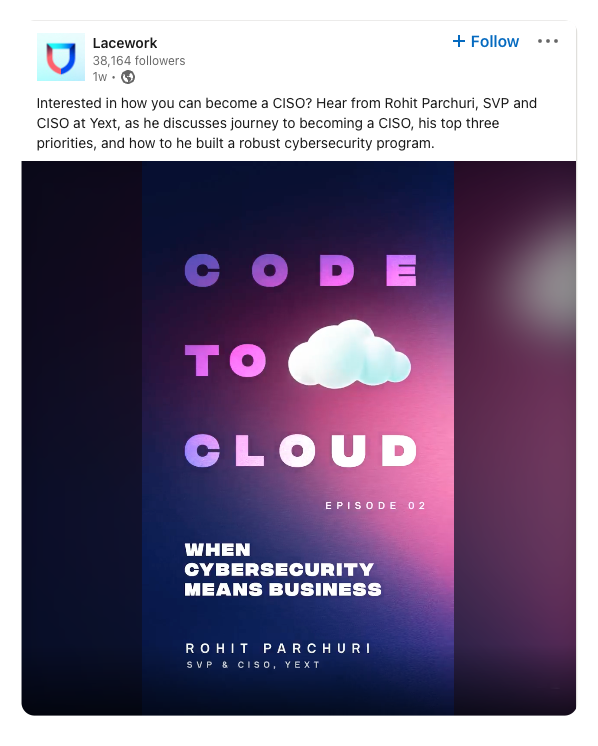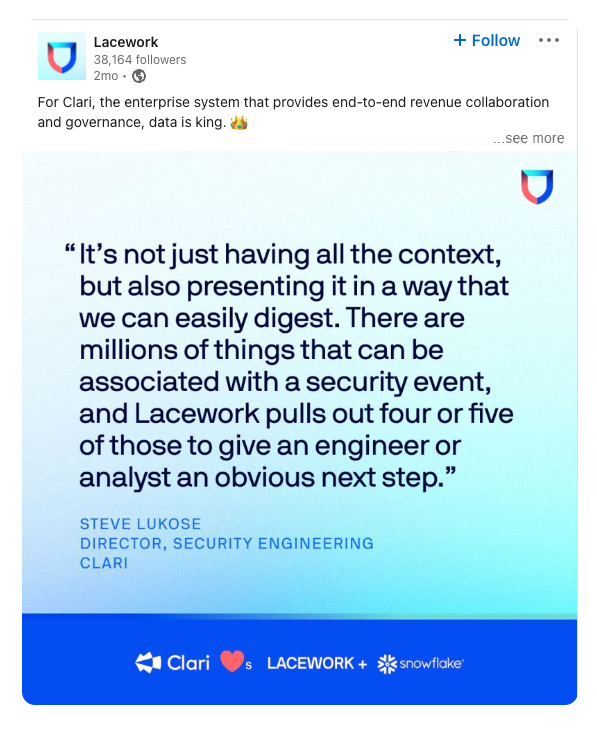


- The Lacework digital marketing team, led by Director of Digital Marketing Simon Chuang, understood their ideal customer profile (ICP) and knew they could reach them successfully on LinkedIn. The ask from the marketing leadership team was simple: build pipeline with ads that drive content downloads on LinkedIn. While those content downloads yielded a healthy volume of leads, many of these leads weren’t converting as quickly or as readily as Simon and his team needed.
- “Accessing content doesn’t mean you’re completely ready for a demo,” Simon noticed. To ensure leads were effectively nurtured and more likely to convert before talking to sales, Lacework needed to diversify its approach to ads on LinkedIn by leveraging different ad formats and customizing their messaging by funnel stage.
Transitioning from bottom-of-funnel lead gen to full-funnel pipeline generation
- The LinkedIn team worked with Simon’s team to develop, deploy, test, and refine a variety of ad formats tailored to each funnel stage. Lacework started incorporating different LinkedIn ad formats, such as Video Ads and Document Ads, that would resonate with customers at various points across the buyer’s journey.
- The Lacework digital marketing team targeted accounts at all stages of purchase intent, ultimately hoping to guide buyers down-funnel into booking a demo.
Strategically delivering content for each funnel stage
Top of funnel Video Ads helped prime Lacework’s audience with easily digestible content
- Lacework kicked off this new full-funnel strategy by running a brand awareness campaign ahead of their standard lead gen (content download) campaign. The team created Video Ads featuring new, easy-to-consume educational content that primed their audience before retargeting them to fill out a lead gen form.
Brand awareness campaigns post demo increased close rates
- Another breakthrough moment for Lacework was discovering the positive impact of running brand awareness campaigns to prospects after they’d had demos with sales. Simon and his team noticed that some high-quality accounts didn’t progress beyond the discovery meeting, and decided to run an A/B test. Those accounts served brand awareness ads saw a 25% higher close rate, demonstrating that staying top of mind moved the needle.
Bottom funnel Conversation Ads delivered to audiences that have already been nurtured
- Further down the funnel, the Lacework team leveraged Conversation Ads, which they found were consistently their best-performing ad format to deliver pipeline and increase sales velocity.
- By developing content that helped nurture leads from zero awareness through discovery, Lacework’s marketing team was able to deliver leads that closed faster and more frequently. This helped the team evolve their point of view on what constituted effective lead generation.
From generating leads to generating pipeline revenue
- As the Lacework team built out their full-funnel strategy, they experienced a significant shift in mindset that enabled stronger conversations around marketing budgets and campaign success. Rather than parse out the cost of marketing to each stage of the funnel, Simon and his team measured success in terms of marketing investment to pipeline revenue won.
- Among the stellar results achieved through this strategic pivot: Lacework saw roughly a 50% increase in sales velocity and 40% increase in qualified leads, with twice as many form-fills. Meanwhile, their CPLs dropped by 30%.
- With a 6X ROI on ad spend, LinkedIn continues to be the best-performing channel for Lacework when it comes to ratio of ad spend to pipeline revenue.





